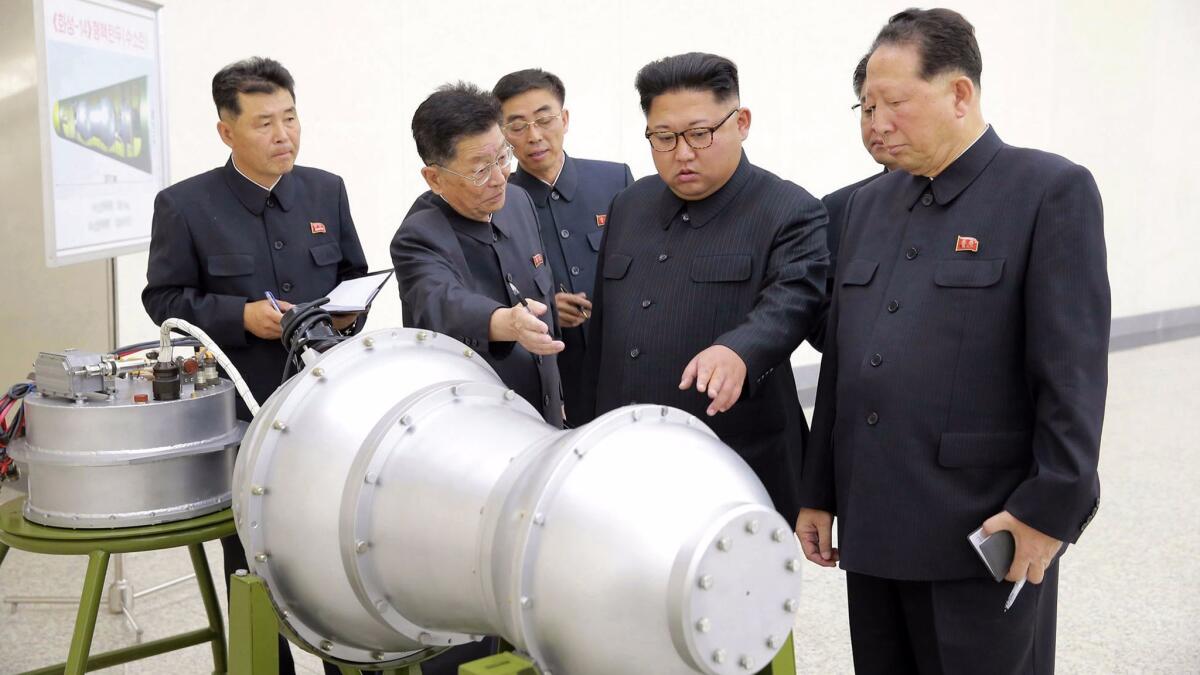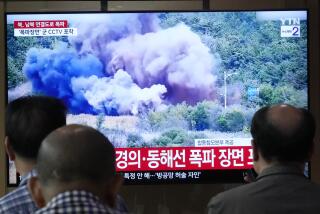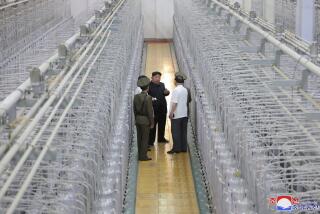The first casualty of North Korean nuclear tests? The country’s environment
- Share via
Reporting from New York — Mt. Paektu is an active volcano that occupies a revered place in Korean legend as the birthplace of the Korean people. But it may be paying a price for their division.
Located on the border of North Korea and China, the volcano has been appropriated by Pyongyang as the “sacred mountain of the revolution.” Propagandists for the Communist state spin a tale, most likely apocryphal, that the late leader Kim Jong Il was born there while his father was a guerrilla fighting the Japanese.
The sacred mountain, however, is just 60 miles from the site where North Korea, now led by Kim’s son, Kim Jong Un, tested its sixth and most powerful nuclear weapon on Sept. 3.
Shortly afterward, Chinese authorities closed part of the tourist park on their side of the border because of rock slides. Chinese authorities would not say definitively whether the nuclear test was to blame, but seismologists think it is likely. The explosion registered as a 6.3 magnitude earthquake and was blamed for water bottles rolling off tables and furniture toppling in China, and apartment buildings rattling all the way to the Russian port city of Vladivostok.
It is just one example of the way that North Korea’s headlong rush to become a nuclear power is degrading the environment in and around the country’s borders.
The first casualty is inside North Korea itself, around the rugged, granite mountains of North Hamgyong province. All six of North Korea’s nuclear tests have taken place there at a site known as Punggye-ri. Satellite images taken after the last test show numerous landslides around the site as well as water leaking from the entrance to one of the tunnels, according to 38 North, an academic website on Korea run by John Hopkins University.

“These disturbances are more numerous and widespread than seen after any of the North’s previous five tests, and include additional slippage in pre-existing landslide scars and a possible subsidence crater,’’ the report said.
Another analysis of satellite data found that Mt. Mantap, a 7,000-foot peak above the test site, actually lost a little elevation from the force of the underground explosion.
“It did move the mountain,” said Jeffrey Lewis, director of the Middlebury center’s East Asia Nonproliferation Program. He believes, however, that there has been no significant leakage of radiation because the test took place in a tunnel more than 3,000 feet below and notes that the visible damage was less extensive than after underground tests in Pakistan. “The North Koreans seem to be pretty good at this. They’ve buried their test site well,” he said.
After the nuclear test, the ground around the test site continued to rumble. Seismologists were particularly stumped by a tremor recorded Sept. 23 that appeared to be a 3.4 magnitude earthquake under Mt. Mantap, an area that does not ordinarily experience earthquakes. A joint report published by the Chinese Academy of Sciences and UC Santa Cruz concluded that tunnels in the test site collapsed.
“It was the mountain collapsing into the cavity created by the explosion ... hundreds of meters below the surface,’’ said Thorne Lay, a professor at UC Santa Cruz.
What analysts are looking for in the satellite images are fissures and craters — which would indicate a breach in the mountain large enough to allow radiation in dangerous quantities to vent to the outside.
“These are minor landslides, nothing like you see in California with mud pouring down,” said Joseph Bermudez, a leading expert on the North Korean military and one of the authors of the 38 North report.
“Still if I were near any nuclear test site, I would be concerned about the environment, especially an active test site,” Bermudez added. “History has shown there are often leakages… and North Korea has not had a really great record as far as environmental protection.”
Every country that has developed a nuclear program has harmed its own people.
— Matthew McKinzie, director of the nuclear program at the Natural Resources Defense Council
North Korea has conducted all six of its nuclear tests around the same site. The Sept. 3 test involved a device estimated at 250 kilotons — 17 times the force of the bomb that destroyed Hiroshima, Japan, in 1945.
“Every country that has developed a nuclear program has harmed its own people,” said Matthew McKinzie, director of the nuclear program at the Natural Resources Defense Council. He compares the situation to East Germany, where the extent of environmental degradation wasn’t known until after reunification in 1990.
The satellite photographs taken after the last test show water draining from the test site that was likely forced out from underground by explosion and could leach into the groundwater. A stream near the test site runs to the nearest sizable city, Kilju, some 25 miles away.
Even closer is the Hwasong labor camp, which is nestled next to Mt. Mantap and houses an estimated 20,000 political prisoners and their families. North Korean defectors in South Korea have said they believe prisoners were used to dig the tunnels of the nuclear test complex.
Satellite images also show that North Korea has failed to dispose safely of nuclear waste. In Pyongsan, tailings are routinely dumped from North Korea’s largest uranium mine into an unlined pond, which is likely to contaminate the groundwater, 38 North has reported.
Defectors have complained as well about the environmental and safety risks of the nuclear program.
“North Korea’s facilities are dilapidated… and North Korea woefully lacks the ability to manage the facilities,’’ wrote a defector group, North Korea Intellectuals Solidarity, in a brochure published last year.
Much of the environmental concern has focused on Mt. Paektu — not only a sacred site for Koreans, but a popular tourist destination for Chinese, who know the mountain as Changbaishan.
“It is deeply embedded in the history of the country, and it’s clearly something that’s hugely important to the Koreans,’’ said James Hammond, a British volcanologist who has inspected the volcano at the invitation of the North Korean government. He and other scientists dismiss scare headlines that appear periodically in tabloids around Asia, warning that nuclear tests could trigger an eruption. However, they believe the nuclear tests could be responsible for the recent rock slides.
The section of the park that was closed Sept. 13 faced south — in the direction of the North Korean nuclear site.
A Chinese travel agent in the area said the mountain isn’t often closed because of falling rocks, but it has happened before. The agent, who did not wish to be quoted by name, said he did not expect the park to open this year.
Daryl Kimball, executive director of the Washington-based Arms Control Assn., said he is most concerned about North Korea’s threat — in response to warnings by President Trump — to conduct the next test in the atmosphere above the Pacific.
Although underground tests pose risks, they are considered much safer than atmospheric tests.
“Underground tests are not environmentally friendly, but there is a vast difference between conducting them in the ground or in the atmosphere,‘’ said Kimball. “If North Korea follows up on the threat to conduct a nuclear test explosion over the Pacific, that would be completely different.”
Special correspondent Matt DeButts in Beijing contributed to this report.
ALSO
Anti-nuclear-weapons group wins Nobel Peace Prize
Two women plead not guilty in death of North Korean leader’s estranged half brother
Trump again undercuts his secretary of State, dashing potential progress on North Korea
More to Read
Sign up for Essential California
The most important California stories and recommendations in your inbox every morning.
You may occasionally receive promotional content from the Los Angeles Times.










